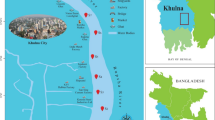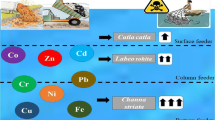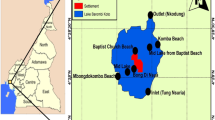Abstract
A study was performed in 2003 to 2004 to assess metal and organic contaminant concentrations at three areas in the lower Cape Fear River system, North Carolina, United States. Sites examined were Livingston Creek along the mainstem of the Cape Fear River near Riegelwood, Six Runs Creek in the Black River Basin, and Rockfish Creek in the Northeast Cape Fear River basin. The results of the investigation showed that levels of metals and organic pollutants in the sediments were lower than limits considered harmful to aquatic life. However, results of fish (adult bowfin) tissue analyses showed that concentrations of arsenic (As), cadmium (Cd), mercury (Hg), selenium (Se), and now-banned polychlorinated biphenyls (PCBs), and the pesticide dieldrin were higher than levels considered safe for human consumption by the United States Environmental Protection Agency and the North Carolina Health Director’s Office. Fish tissue concentrations of Hg, Se, and PCBs were also higher than concentrations determined by researchers to be detrimental either to the health of the fish themselves or their avian and mammalian predators. Due to the rural nature of two of the sites, increased concentrations of As, Cd, Se, and PCBs in fish tissue were unexpected. The likely reason the levels are increased in fish and some clams but not in sediments is that these pollutants are biomagnified in the food chain. These pollutants will also biomagnify in humans. In these rural areas there is subsistence fishing by low-income families; thus, increased fish tissue metals and toxicant concentrations may present a direct threat to human health.




Similar content being viewed by others
References
Chalmers AT, Argue DE, Gay DA, Brigham ME, Schmitt CJ, Lorenz DL (2010) Mercury trends in fish from rivers and lakes in the United States, 1969-2005. Environ Monit Assess. doi:10.1007/s10661-010-1504-6
Colborn T, Thayer K (2000) Aquatic ecosystems: harbingers of endocrine disruption. Ecol Appl 10:949–957
Cooksey C, Hyland J, Wirth E, Balthis WL, Fulton M, Whitall D et al (2008) Support for integrated ecosystem assessments of NOAA’s National Estuarine Research Reserves System (NERRS) vol II: assessment of ecological condition and stressor impacts in subtidal waters of the North Carolina NERRS. NOAA Technical Memorandum NOS NCCOS 83, NOAA Center for Environmental Health and Biomolecular Research, Charleston, SC
Crutchfield JU (2000) Recovery of a power plant cooling reservoir ecosystem from selenium bioaccumulation. Environ Sci Pollut 3(Suppl 1):S145–S163
Evers DC, Han Y, Driscoll CT, Kamman NC, Goodale MW, Lambert KF et al (2007) Biological mercury hotspots in the Northeastern United States and Southeastern Canada. Bioscience 57:29–43
Fulton MH, Scott GI, Fortner A, Bidleman TF, Ngabe B (1993) The effects of urbanization on small high salinity estuaries of the southeastern United States. Arch Environ Contam Toxicol 25:476–484
Gillespie RB, Bauman PC (1986) Effects of high tissue concentration of selenium on reproduction by bluegill. Trans Am Fish Soc 115:208–213
Hyland JL, Balthis WL, Hackney CT, Posey ME (2000) Sediment quality of North Carolina estuaries: an integrative assessment of sediment contamination, toxicity, and condition of benthic fauna. J Aquat Ecosyst Stress Recov 8:107–124
Kamman K, Blankenship AL, Jones PD, Giesy JP (2000) Toxicity reference values for the toxic effects of polychlorinated biphenyls to aquatic mammals. Hum Ecol Risk Assess 6:181–201
King RS, Beamon JR, Whigham DF, Hines AF, Baker ME, Weller DE (2004) Watershed land use is strongly linked to PCBs in white perch in Chesapeake Bay subestuaries. Environ Sci Technol 38:6546–6552
Lemly AD (1993) Guidelines for evaluating selenium data from aquatic monitoring and assessment studies. Environ Monit Assess 28:83–100
Long ER (2000) Degraded sediment quality in US estuaries: a review of magnitude and ecological implications. Ecol Appl 10:338–349
Long ER, McDonald DD, Smith SL, Calder FD (1995) Incidence of adverse biological effects within ranges of chemical concentrations in marine and estuarine sediments. Environ Manage 19:81–97
MacDonald DD, Ingersoll CG, Berger TA (2000) Development and evaluation of consensus-based sediment quality guidelines for freshwater ecosystems. Arch Environ Contam Toxicol 39:20–31
Mallin MA (2000) Impacts of industrial-scale swine and poultry production on rivers and estuaries. Am Sci 88:26–37
Mallin MA, Ensign SH, McIver MR, Shank GC, Fowler PK (2001) Demographic, landscape, and meteorological factors controlling the microbial pollution of coastal waters. Hydrobiologia 460:185–193
Matthews TD (1994) Contaminants in recreationally important estuarine finfish from South Carolina. Bull Environ Contam Toxicol 53:412–419
North Carolina Department of Environment, Natural Resources (2001) Standard operating procedures, stream fish community assessment and fish tissue. NCDENR, Division of Water Quality, Water Quality Section. Environmental Sciences Branch, Biological Assessment Unit, Raleigh, NC
North Carolina Department of Environment, Natural Resources (2005) Cape Fear Basinwide water quality plan. North Carolina Department of Environment and Natural Resources. Division of Water Quality, Raleigh, NC
Peterson SA, Van Sickle J, Herlihy AT, Hughes RM (2007) Mercury concentrations in fish from streams and rivers throughout the western United States. Environ Sci Technol 41:58–65
Rohde FC, Arndt RG, Foltz JW, Quattro JM (2009) Freshwater fishes of South Carolina. University of South Carolina Press, Columbia, SC
Sanger DM, Holland AF, Scott GI (1999a) Tidal creek and salt marsh sediments in South Carolina coastal estuaries: I. Distribution of trace metals. Arch Environ Contam Toxicol 37:445–457
Sanger DM, Holland AF, Scott GI (1999b) Tidal creek and salt marsh sediments in South Carolina coastal estuaries: I. Distribution of organic contaminants. Arch Environ Contam Toxicol 37:458–471
Sanger DA, Blair A, DiDonato G, Washburn T, Jones S, Chapman R, et al. (2008) Support for integrated ecosystem assessments of NOAA’s National Estuarine Research Reserves System (NERRS) vol I: the impacts of coastal development on the ecology and human well-being of tidal creek ecosystems of the US southeast. NOAA Technical Memorandum NOS NCCOS 82, NOAA Center for Environmental Health and Biomolecular Research, Charleston, SC
Schantz MM, Demiralp R, Greenberg RR, Hays MJ, Parris RM, Porter BJ et al (1997) Certification of a frozen mussel tissue standard reference material (SRM 1974a) for trace organic constituents. Fresenius J Anal Chem 358(3):431–440
United States Environmental Protection Agency (2000a) Guidance for assessing chemical contaminant data for use in fish advisories, vol 1: fish sampling and analysis. EPA-823-B-00–007. USEPA, Office of Water, Washington, DC
United States Environmental Protection Agency (2000b) Guidance for assessing chemical contaminant data for use in fish advisories, vol 2: risk assessment and fish consumption limits. EPA-823-B-00–008. USEPA, Office of Water, Washington, DC
United States Environmental Protection Agency (2004) National coastal condition report II. EPA-620/R-03/002. USEPA, Office of Research and Development. Office of Water, Washington, DC
Van Dolah RF, Riekerk GHM, Bergquist DC, Felber J, Chestnut DE, Holland AF (2008) Estuarine habitat quality reflects urbanization at large spatial scales in South Carolina’s coastal zone. Sci Total Environ 390:142–154
Van Metre PC, Mahler BW, Furlong ET (2000) Urban sprawl leaves it’s PAH signature. Environ Sci Technol 34:4064–4070
Weis JS, Weis P (1989) Effects of environmental pollutants on early fish development. Rev Aquat Sci 1:45–73
Woock SE, Garrett WR, Partin WE, Bryson WT (1987) Decreased survival and teratogenesis during laboratory selenium exposures to bluegill Lepomis macrochirus. Bull Environ Contam Toxicol 39:998–1005
Acknowledgments
We thank the North Carolina Attorney General’s Office for funding through the Smithfield Agreement to the Lower Cape Fear River Program at the University of North Carolina Wilmington. We thank James Merritt (UNCW) and Geoff Scott (NOAA) for facilitation and Mike Williams for field collection help.
Disclaimer
The National Ocean Service does not approve, recommend, or endorse any proprietary product or material mentioned in this publication. Certain commercial equipment, instruments, or materials are identified in this article to specify adequately the experimental procedure. Such identification does not imply recommendation or endorsement, nor does it imply that the materials or equipment identified are necessarily the best available for the purpose.
Author information
Authors and Affiliations
Corresponding author
Rights and permissions
About this article
Cite this article
Mallin, M.A., McIver, M.R., Fulton, M. et al. Elevated Levels of Metals and Organic Pollutants in Fish and Clams in the Cape Fear River Watershed. Arch Environ Contam Toxicol 61, 461–471 (2011). https://doi.org/10.1007/s00244-010-9633-z
Received:
Accepted:
Published:
Issue Date:
DOI: https://doi.org/10.1007/s00244-010-9633-z




